Home to approximately 52 species from about 9 distinct families, Texas boasts a fascinating diversity of lizards. These reptiles display an array of shapes, colors, and sizes, with the smallest comfortably fitting in your hand and the largest measuring up to a small dog. As one of the largest states in the U.S., Texas presents a multitude of ecosystems that create ideal habitats for these lizards.
In this comprehensive guide, we delve into the intriguing world of lizards in Texas, providing vital information to help you identify these species based on their appearance, behavior, and geographical distribution within the state. Notably, certain species bear striking resemblances to each other and can only be distinguished by subtle differences.
Let’s embark on this journey to explore the 52 lizard species you might encounter in Texas. While some are commonly sighted, others represent threatened populations, making this exploration both enlightening and significant.
Table of Contents
Lizards in Texas
Dactyloidae
1. Green Anole
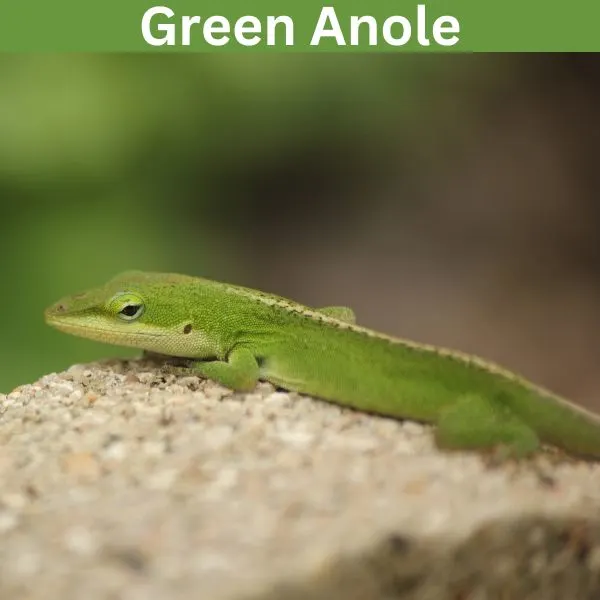
- Experience Level: Beginner
- Family: Dactyloidae
- Scientific Name: Anolis carolinensis
- Other Names: American anole, Red-throated anole
- Adult Size: 5 to 8 in. (12.7 to 20.32 cm.)
- Lifespan: 5 to 8 years
- Average Price Range: $10
Green anoles are one of the most common lizards in Texas. These species live in moist, and shady environments. They enjoy places with lots of vegetation like trees and bushes. Urban areas are where you may see these lizards, and they enjoy climbing on things like walls and trees. Found in the eastern United States, green anoles live in the eastern third of Texas.
Green anoles are slender, with green, gray, or brown coloring. The heads of these lizards are large and narrow. Males under their chin have a bright-colored dewlap that helps them attract a mate. To help them camouflage, green anoles are able to change their color like a chameleon.
Small insects and invertebrates are what green anoles eat. Males can be very territorial, and aggressive with others in the breeding season. Native to Texas, green anoles have a stable population in the state.
2. Brown Anole
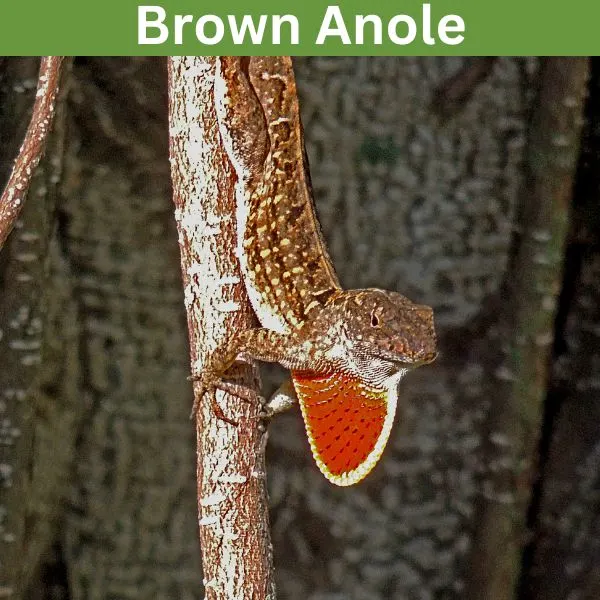
- Experience Level: Beginner
- Family: Dactyloidae
- Scientific Name: Anolis sagrei
- Other Names: Bahaman Anole, Cuban Brown Anole
- Adult Size: 5 to 9 in. (12 to 22.86 cm)
- Lifespan: 5 years
- Average Price Range: $10
Brown anoles are an invasive lizard in Texas and are native to Cuba, and the Bahamas. These lizards live in tropical environments with lots of plants, and humidity. Brown anoles can be a threat to native lizards since this species can breed and spread rapidly.
Brown to grayish is the color of these lizards. They are typically darker in color than green anoles. They have short heads, with spots, stripes, or lines on them. Males are heavier than females, and have a bright orange dewlap under their chin.
Brown anoles are sometimes kept as pets, which is how these lizards can become invasive to new areas. You may find these lizards in urban areas. They are most active in the summer, during the day.
Eublepharidae
3. Texas Banded Gecko

- Experience Level: Beginner
- Family: Eublepharidae
- Scientific Name: Coleonyx brevis
- Other Names: n/a
- Adult Size: 4 in. (10 cm.)
- Lifespan: 15 years
- Average Price Range: $40
Texas banded geckos are found in western Texas, but are also seen in southeastern New Mexico. These lizards are active at night. They are sometimes kept as pets since they are very docile and easy to care for. Semi-arid habitats with lots of rocks are where Texas banded geckos live.
Small in size, these lizards have yellow, brown, or pink coloring. They have bands on them with dark spots. As this species grows, a mottled pattern becomes more prominent on them.
The night is when geckos hunt. You may hear them make small squeaking or squealing noises. The spring is when these lizards mate, and they lay up to two eggs. Insects they find at night are what this gecko typically eats.
4. Reticulated Banded Gecko

- Experience Level: Intermediate
- Family: Eublepharidae
- Scientific Name: Coleonyx reticulatus
- Other Names: n/a
- Adult Size: 6.5 in. (16.51 cm.)
- Lifespan: 15 years
- Average Price Range: n/a
The reticulated banded gecko is native to Texas. This species is active at night and live in semi-arid, rocky environments. Reticulated banded geckos may squeak but this usually occurs if they are being handled. Reticulated banded geckos are listed as a threatened species in Texas, and only live in remote areas.
These lizards are medium-sized, with pink or brown coloring. They have banding on them, with black spots. This lizard is very similar to the Texas banded gecko but is larger in size.
Small arthropods are what this lizard eats. These lizards are terrestrial and spend their time climbing around rocks. In some of their range, like that of Big Bend National Park, this lizard is protected.
Gekkonidae
5. Keeled Rock Gecko

- Experience Level: Intermediate
- Family: Gekkonidae
- Scientific Name: Cyrtopodion scabrum
- Other Names: Common Tuberculate Ground Gecko
- Adult Size: 3 to 4.6 in. (7.5 to 11.7 cm)
- Lifespan: 10 years
- Average Price Range: $15
Rough-tailed geckos are a species native to Asia and are invasive to Texas. This lizard is very abundant around the globe and has a tendency to become invasive. It is believed they travel to new areas by using ports, and ships.
Rough-tailed geckos have a slender and bumpy appearance. They have tan to yellowish coloring, with dark brown blotches and bands covering them. Their tails are thin, and they’re very rough.
Rough-tailed geckos have been able to establish a population in Texas. They may be a threat to some of the native lizards. Buildings are where this species lives, and you are not likely to come by this lizard.
6. Common House Gecko

- Experience Level: Intermediate
- Family: Gekkonidae
- Scientific Name: Hemidactylus frenatus
- Other Names: Pacific House Gecko, Moon Lizard
- Adult Size: 3 to 6 in. (7.5 to 15 cm.)
- Lifespan: 5 years
- Average Price Range: n/a
Common house geckos are native to Asia and are one of the few invasive lizards in Texas. These lizards are active at night. They are common in urban areas and may be seen climbing fences or walls. Tropical environments are where these lizards are found most.
Common house geckos have a tan or brownish coloring. They have an elongated tail, with a very mottled pattern on them. The pattern on them is marbled, but their underside is plain, and cream white. The eyes of these lizards are yellowish, and they have elliptical eyes.
At night these lizards are very active and may be seen scurrying for food. Common house geckos are insectivores. The ability to breed quickly is how these lizards can become invasive. Females can keep sperm in their bodies for up to 36 weeks to fertilize their eggs. Sometimes geckos are kept as pets and need a humid, environment with a heat source.
7. Mediterranean House Gecko
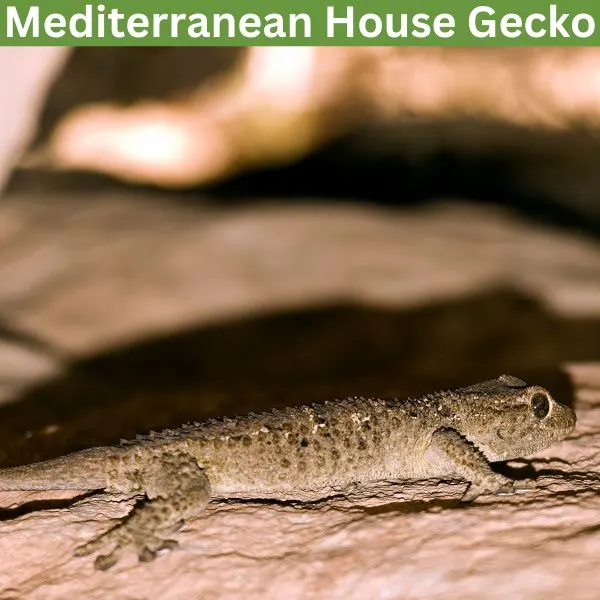
- Experience Level: Beginners
- Family: Gekkonidae
- Scientific Name: Hemidactylus turcicus
- Other Names: Moon Lizard, Turkish Gecko
- Adult Size: 4 to 5 in. (10 to 13 cm.)
- Lifespan: 3 to 9 years
- Average Price Range: $10
The Mediterranean house gecko is native to the Mediterranean region as their name suggests. These lizards are invasive to Texas. They are active at night, which is why some call them the moon lizard. Mediterranean house geckos prefer habitats near human buildings, such as homes, and cemeteries.
These lizards are small and have a yellowish, cream coloring. They are very bumpy, with a mottled pattern covering them. The toes of these lizards have pads on them to help them climb. They have yellow, cat-like eyes.
Mediterranean house geckos sometimes are seen together, hiding under objects like rocks, or boards. At night insects are what they hunt for. These lizards may reproduce in the spring to fall months. These lizards can be aggressive to others to defend their mates.
Scincidae
8. Southern Coal Skink

- Experience Level: Intermediate
- Family: Scincidae
- Scientific Name: Plestiodon anthracinus pluvialis
- Other Names: n/a
- Adult Size: 5.1 to 7.1 in. (13 to 18 cm.)
- Lifespan: 6 years
- Average Price Range: n/a
Southern coal skinks are one of the few skinks native to Texas. These lizards live in east Texas. Southern coal skinks have a scattered population across the southern United States. They live in hillsides, woodlands, and rocky regions. It is common for these lizards to live near, and take refuge around water.
These lizards are medium-sized and have four lines running down their body. They have a tan, to black coloring. These skinks may have red coloring on their face in the breeding season. Overall they have a tan, olive, or brown color.
Spring, to fall is when these lizards are active most, and they spend this period breeding. Females lay around 8 to 9 eggs in a clutch. Small insects they find under rocks, on the ground, or in the leaf litter are what these southern coal skinks eat.
9. Common Five-lined Skink
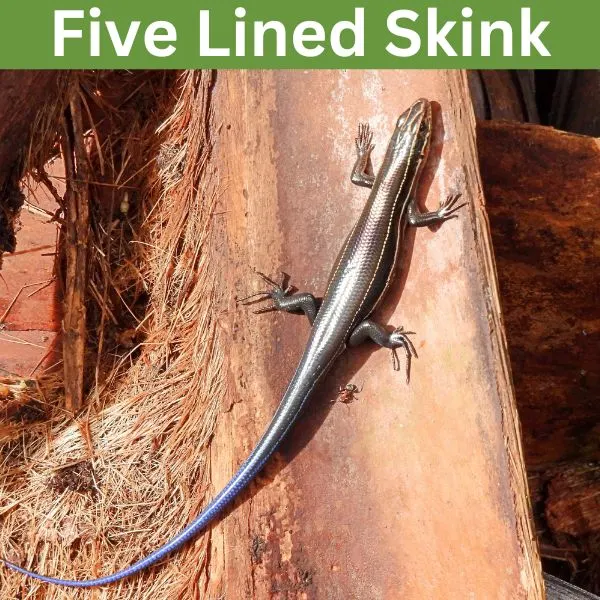
- Experience Level: Intermediate
- Family: Scincidae
- Scientific Name: Plestiodon fasciatus
- Other Names: American five-lined skink
- Adult Size: 4.9 to 8.5 in. (12.5 to 21.5 cm)
- Lifespan: 6 years
- Average Price Range: $12
Five-lined skinks live in eastern Texas and are native to the eastern United States. Woodlands, streams, or rivers are common habitats in which these lizards live. Five-lined skinks may hide under rocks, or leaf litter, and are terrestrial.
This species gets its name from the five lines that run down their back. Like other skinks when young they have a bright blue tail, which may fall off if stressed. The blue color fades with age. They have a black, to olive green coloring on their body, and five yellow lines running down them.
Five-lined skinks breed in the spring, and summer months. Males may mate with multiple females, which lay their eggs in moist, and hidden areas. Five-lined skink eggs take around 2 months to hatch. These lizards are very common and have a stable population in their range.
10. Broad-headed Skink

- Experience Level: Intermediate
- Family: Scincidae
- Scientific Name: Plestiodon laticeps
- Other Names: Broadhead Skink, Red-headed Scorpion
- Adult Size: 5.9 to 13 in. (15 to 33 cm.)
- Lifespan: 4 to 8 years
- Average Price Range: n/a
Broad-headed skinks live in woodlands and oak wood habitats. This species is native to the eastern United States, and they are only found in eastern Texas. Broad-headed skinks are semi-arboreal, and you may see them in the trees, or on the ground.
Broad-headed skinks are one of the largest types of skinks you can find in Texas. The head of this lizard has very wide jaws. Brown or olive are the colors this lizard appears in. Males have a bright red head in the breeding season. When young this lizard has brown, or black coloring, with stripes, and a blue tail.
Broad-headed skinks are not dangerous, though some may think of them as venomous due to their bright colors when breeding. These lizards feed on small insects, spiders, and other invertebrates they can find during the day.
11. Many-lined Skink

- Experience Level: Beginner
- Family: Scincidae
- Scientific Name: Plestiodon multvirgatus
- Other Names: Variable Skink, Northern Many-lined Skink
- Adult Size: 3 to 7.5 in. (7.5 to 19 cm.)
- Lifespan: 6 years
- Average Price Range: n/a
Many-lined skinks can be found in western Texas. They live in highly elevated rocky habitats. These lizards prefer places with sandy soil. They are found at elevations up to 8,500 ft.
Many-lined skinks are medium in size. They have brown, or olive coloring. A black stripe appears on this lizard’s side, and males may have reddish coloring on the side of their faces. When born like other skinks this species has a blue tail which fades with age.
When mating many-lined skinks lay their eggs under rocks in moist environments, and can have between 3 to 9 eggs. Many-lined skinks may hide in vegetation, and spend their days feeding on small invertebrates.
12. Great Plains Skink
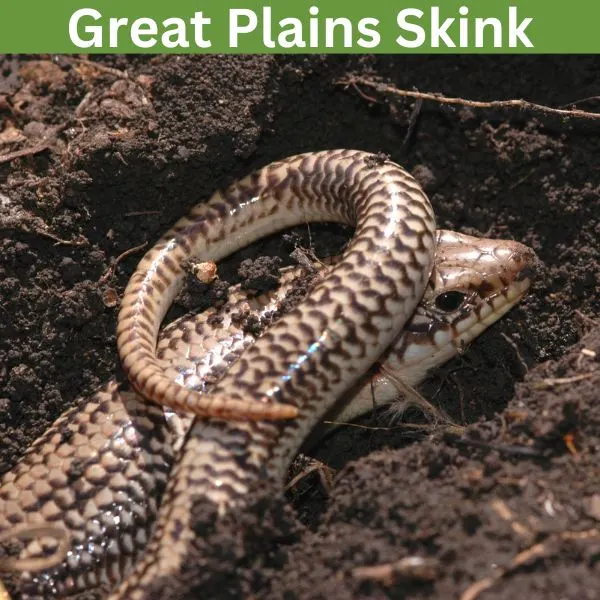
- Experience Level: Beginner
- Family: Scincidae
- Scientific Name: Plestiodon obsoletus
- Other Names: 3.5 to 5.11 in. (9 to 13 cm.)
- Adult Size: 6.5 to 13.75 in. (16.51 to 34.9 cm.)
- Lifespan: 3 years
- Average Price Range: $50
Great Plains skink lives in the western, and central regions of Texas. This lizard lives in the foothills of the Rocky Mountains. They are active in the spring to mate and lay between 5 to 32 eggs in the summer. Females guard their eggs until they hatch, and disperse.
Great Plains skinks are one of the largest skinks in the Plestiodon genus. These lizards have a grey, or beige coloring, with a dark, or brown mottled pattern on them. They have a yellow belly. When born these skinks have a blue tail, with black coloring.
Insects like crickets and beetles are what this species eats. They may also feed on smaller lizards. Birds and small mammals may feed on this species and their eggs. Great Plains skinks have a stable population, with a status listed as “least concern” by the IUCN.
13. Southern Prairie Skink
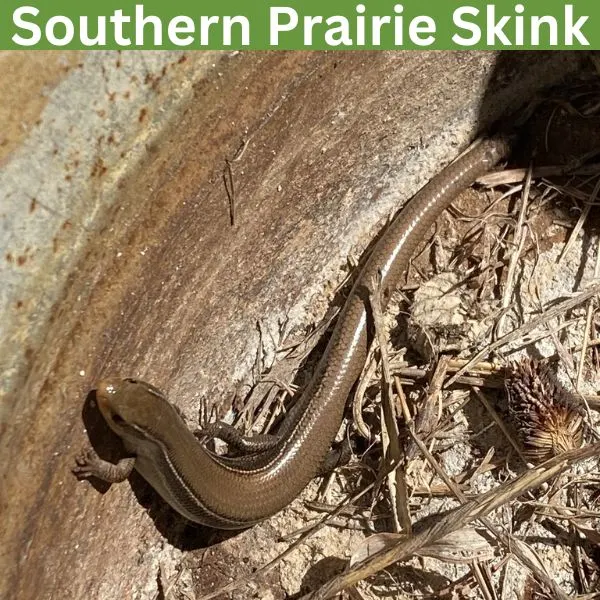
- Experience Level: Beginner
- Family: Scincidae
- Scientific Name: Plestiodon s. obtusirostris
- Other Names: n/a
- Adult Size: 5 to 9 in. (13 to 22 cm.)
- Lifespan: n/a
- Average Price Range: n/a
The southern prairie skink is a subspecies of prairie skink that is found in Texas. This species lives in grasslands, and open habitats with loose, and sandy soil. They enjoy habitats with nearby water sources. You may find this species hiding under debris like rocks, or logs.
Southern prairie sinks are small, with brown or tan coloring. They have stripes that run down their body. This skink is not seen often due to its secretive nature. Southern prairie skinks are darker on their sides, and their bellies are plain white.
This skink is not seen often due to its secretive nature. The breeding season of spring is when this lizard is spotted most. Spiders, crickets, and ants are prey this lizard feeds on.
14. Four-lined Skink

- Experience Level: Beginner
- Family: Scincidae
- Scientific Name: Plestiodon tetragrammus
- Other Names: n/a
- Adult Size: 7.1 in. (18 cm.)
- Lifespan: 6 years
- Average Price Range: n/a
The four-lined skink is found in central, and southwestern Texas. This lizard is only found in Texas, and in Mexico. The short-lined skink is a subspecies of this skink that also lives in the state. Subspecies and regular species can be told apart by subtle differences, and this skink’s main tell is its stripes.
Four-lined skinks are named after the lines that run down their body. This species has a black, olive, or tan coloring. They have a blue tail when young, that fades with age. Short-lined skinks are darker, and their stripes end before their forelegs.
Four-lined skinks may lay between 5 to 12 eggs yearly. Males can have orange coloring on their heads to attract mates. This small skink feeds on insects and other invertebrates they find on the ground.
15. Little Brown Skink
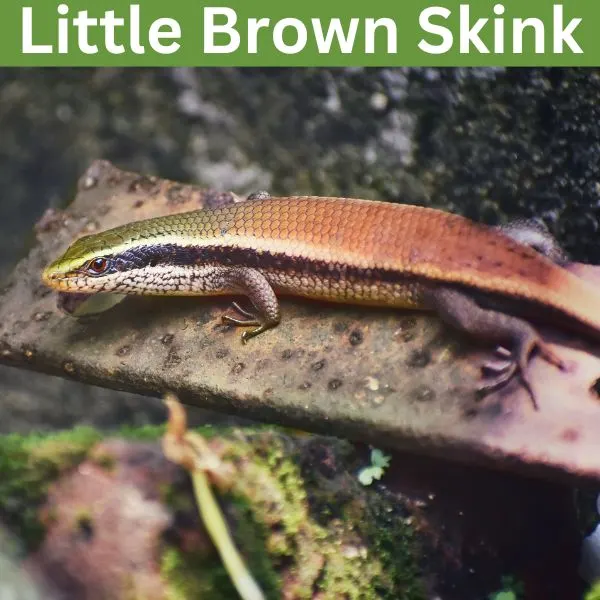
- Experience Level: Beginner
- Family: Scincidae
- Scientific Name: Scincella lateralis
- Other Names: Ground Skink, Brown-backed Skink
- Adult Size: 3 to 5.25 in. (7.62 to 13.3 cm.)
- Lifespan: 2.5 years
- Average Price Range: $5
Little brown skinks are found in eastern, and southeastern Texas. This lizard lives in wooded habitats near water sources. Little brown skinks are found in leaf litter, and loose soil. A deep substrate is required for this species to live, as they are fossorial.
Compared to other skinks this species is very small. They have a tan or copper color and are covered in small specks. The bellies of this lizard is a plain white or yellow. Little brown skinks are one of the smallest reptiles in the United States. They have very small limbs and slender bodies.
Insects, spiders, and other small invertebrates they find while foraging are what this species eats. They flick out their tongues to make it easier to sense the chemical trails left behind by prey. Birds, larger lizards, and even snakes are some of the predators these small lizards may be eaten by.
Phrynosomatidae
16. Greater Earless Lizard

- Experience Level: Intermediate
- Family: Phrynosomatidae
- Scientific Name: Cophosaurus texanus
- Other Names: n/a
- Adult Size: 2.6 to 5.3 in. (6.6 to 13.4 cm)
- Lifespan: 3 years
- Average Price Range: $15
Greater earless lizards are a lizard found in Texas and other regions in the southwestern United States. This species lives in semi-arid habitats. They are typically found in open areas with lots of rocks, sand, and sparse vegetation. The subspecies of greater earless lizards that exist include the Texas greater earless lizard, Sonoran greater earless lizard, and the Chihuahuan greater earless lizard.
Greater earless lizards are medium size. They have no external ear opening. This species can have tan, green, orangish, or gray coloring, with stripes and blotches on them. Males are more colorful and are also larger.
This lizard is active during the day and is able to tolerate high heat. They feed mainly on insects. To be able to escape predators like birds or snakes this lizard is very quick. Their coloring also helps the greater earless lizard blend better into desert environments.
17. Plateau Earless Lizard

- Experience Level: Intermediate
- Family: Phrynosomatidae
- Scientific Name: Holbrookia lacerata
- Other Names: n/a
- Adult Size: 4.5 to 6.1 in. (11.5 to 15.4 cm.)
- Lifespan: n/a
- Average Price Range: n/a
The spot-tailed earless lizard is a species found in southern Texas. This lizard lives in meadows, prairies, and savannah habitats. They are native to the state, and their natural range has been affected due to conditions like livestock pollution, and loss of habitats.
Spot-tailed earless lizards are named after having no ear holes, like most other reptiles. Tan, olive, reddish, and orange are their coloring, and they have spots on them.
Spotted earless lizards eat ants, but can be easily eaten by fire ants that are invasive to the state. Spotted earless lizards are considered a near-threatened species, and are rare to find in the state.
18. Eastern Earless Lizard

- Experience Level: Intermediate
- Family: Phrynosomatidae
- Scientific Name: Holbrookia maculata perspicua
- Other Names: n/a
- Adult Size: 4.5 to 6 in. (11 to 15 cm.)
- Lifespan: 1 to 3 years
- Average Price Range: n/a
Great Plains earless lizards are a species found in the Central United States. They live in prairies and grassland habitats. This species is native to northern Texas and also inhabits Oklahoma.
Prairie earless lizards have gray, brown, or olive coloring. They have dark blotches on their side, and light stripes running in the middle of their back. Males have black and white markings on their hind legs. This species has no external ear holes and can look similar to other earless lizards.
Great Plains’ earless lizards feed on insects and are active during the day. You can often see them basking in the sun since cold-blooded animals cannot regulate their body.
19. Lesser Earless Lizard

- Experience Level: Intermediate
- Family: Phrynosomatidae
- Scientific Name: Holbrookia maculata
- Other Names: n/a
- Adult Size: 4 to 5 in. (10 to 13 cm.)
- Lifespan: 3 to 7 years
- Average Price Range: n/a
Lesse earless lizards are found in central, and the southwestern United States. This species lives in grasslands, shrublands, and desert habitats. Lesser earless lizards have various subspecies. They are common and listed as “least concern”, but in some parts of their range, they are in need of conservation.
Lesser earless lizards are smaller, with smooth scales. They have no ear openings, and a tan, to olive color. The underside of the female species’ throat has an orange color in the breeding season. Stripes, blotches, and a mottled partner can cover this species. Like other similar lizards, this species has no ear holes.
Lesser earless lizards feed on insects and spiders. This lizard is active during the day and is seen in the summer and fall months. When breeding this lizard can lay between 4 or 6 eggs.
20. Keeled Earless Lizard

- Experience Level: Intermediate
- Family: Phrynosomatidae
- Scientific Name: Holbrookia propinqua
- Other Names: n/a
- Adult Size: 5.5 in. (14 cm.)
- Lifespan: 3 t o7 years
- Average Price Range: n/a
Keeled earless lizards live in the extreme south of Texas. Oak woodlands, mesquite brush, prairies, and grasslands are some of the habitats this lizard lives in. There are three subspecies of earless lizards, and this species is not that common.
Keeled earless lizards are small, and have a colorful appearance. They have tan, beige, gray, or olive coloring. Their sides have yellow, green, pink, and reddish markings on them. Like other earless lizards, this species has no ear hole.
Keeled earless lizards are active during the day, and feed on small insects they find. The pattern on them helps this species camouflage in dry bush environments, and hide from predators like birds, or carnivorous mammals.
21. Southern Spot-tailed Earless Lizard

- Experience Level: Intermediate
- Family: Phrynosomatidae
- Scientific Name: Holbrookia subcaudalis
- Other Names: n/a
- Adult Size: 4.5 to 6.1 in. (11.5 to 15.4 cm.)
- Lifespan: 3 to 7 years
- Average Price Range: n/a
Southern spot-tailed lizards are native to the United States, and are found in southern Texas. This species lives in agricultural fields, hills, and semi-arid environments. This lizard was once a subspecies of Holbrookia lacerata, until it become its own species.
Southern spot-tailed earless lizards have no external ear holes. They have a tan, or gray coloring, with blotches and stripes on them. This lizard when pregnant will have a greenish-yellow hue.
You can find this lizard out in the day looking for insects to eat. They reproduce by laying eggs, mating in the spring and summer. Not much is known about this lizard, due to their limited range in Texas.
22. Texas Horned Lizard
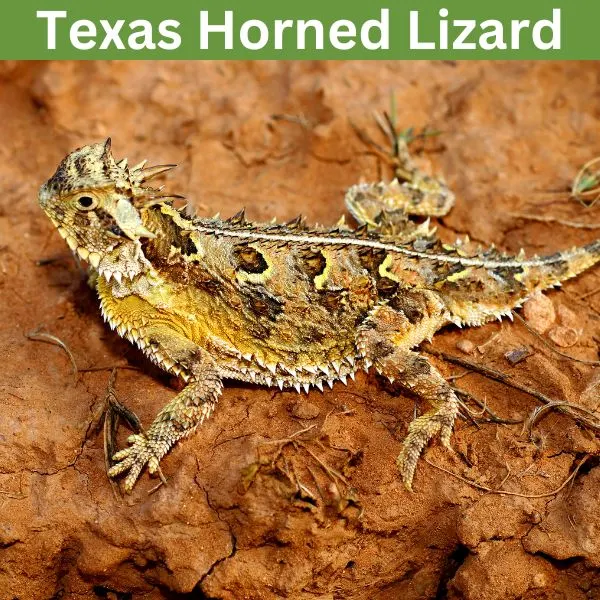
- Experience Level: Advanced
- Family: Phrynosomatidae
- Scientific Name: Phrynosoma cornutum
- Other Names: Horny Toad
- Adult Size: 3.7 to 5 in. (9.93 to 12.7 cm.)
- Lifespan: 5 years
- Average Price Range: $40
Texas horned lizards are found in most of Texas. This lizard is native to the south-central United States and is also found in Mexico. Texas horned lizards live in desert habitats with sparse vegetation.
Horned lizards like this species are covered in spikes, that make it easier for them to blend into the sparse desert vegetation. They have round bodies, with a flat appearance. This lizard is tan and has a mottled pattern covering them. Horns cover them from their head to the sides.
This lizard is able to squirt blood out of its eyes to protect itself. Their spikes and shape make them less palatable to predators like birds, and snakes. Texas horned lizards feed on insects, mainly ants.
23. Greater Short-horned Lizard

- Experience Level: Intermediate
- Family: Phrynosomatidae
- Scientific Name: Phrynosoma hernandesi
- Other Names: Mountain short-horned lizard
- Adult Size: 6 in. (15 cm.)
- Lifespan: n/a
- Average Price Range: $40
Greater short-horned lizards live south in Texas past the Texas Pandle. This lizard lives in arid mountain habitats, with sparse vegetation. They are active in the day, in the evening, and at night burrow into the ground.
The body of this lizard is round and flat. They are covered in small spikes and have a tan, to grayish coloring. Greater short-horned lizards have a mottled pattern, and bands covering them.
Grasshoppers, beetles, and ants are some of the prey this lizard eats. Camouflage is how this species avoids predators. They can also squirt blood from their eyes to ward off dogs, but this is rare.
24. Roundtail Horned Lizard

- Experience Level: Intermediate
- Family: Phrynosomatidae
- Scientific Name: Phrynosoma modestum
- Other Names: n/a
- Adult Size: 2.7 to 4.3 (7 to 10.5 cm)
- Lifespan: 7 years
- Average Price Range: n/a
Roundtail horned lizards are found in western Texas, and other regions in the southwestern United States. This lizard lives in rocky habitats with sparse vegetation. They often live near harvester ants, or other ants to feed on.
Round tail horned lizards have grey, brown, or yellowish coloring. Their shade matches the habitats they live in to help them camouflage. This lizard has a round body, with horns on their head, and small spikes on them. They have a mottled pattern with bands on their tail and legs.
Summer is when this lizard breeds, and lay their eggs. Roundtail horned lizards are not seen often in Texas since they are secretive and blend in so well into their habitats.
25. Dunes Sagebrush Lizard

- Family: Phrynosomatidae
- Scientific Name: Sceloporus arenicolus
- Other Names: n/a
- Adult Size: 2.8 in. (6.5 cm)
- Lifespan: 2 years
- Average Price Range: n/a
In Texas the dunes sagebrush lizard is extremely rare, and is only found in a few counties that border New Mexico. This lizard lives in sand dune habitats. This lizard has the second smallest range of all the lizards inhabiting the United States.
Dunes sagebrush lizards have a yellow-sandy color. They are a small species, and may not be seen since they blend well into the sand dunes they live in. They burrow themselves n a retreat when too hot or cold.
Herbicides and competition with other lizards are why this species’ population has declined. They are an endangered species, with conservation efforts put in place to preserve them, in both Texas and New Mexico.
26. Prairie Lizard

- Experience Level: Intermediate
- Family: Phrynosomatidae
- Scientific Name: Sceloporus consobrinus
- Other Names: Southern Prairie Lizard
- Adult Size: 4 to 7 in. (10.16 to 17.78 cm.)
- Lifespan: n/a
- Average Price Range: n/a
Praire lizards are common in the southern United States, and are found in grasslands, and other similar habitats. This lizard is active during the day. They are not very common, and not much is known about this species.
Prairie lizards have light brown, to gray colors. They have very keeled scales, with white markings on them. Their bellies and necks are blue in the mating season.
This lizard feeds on insects and other invertebrates. They are fed on by animals like birds and use their camouflage to hide from predators.
27. Southwestern Fence Lizard

- Experience Level: Intermediate
- Family: Phrynosomatidae
- Scientific Name: Sceloporus cowlesi
- Other Names: White Sands Swift, Cowles’ Prairie Lizard
- Adult Size: 3 to 8.4 in. (7.6 to 21.33 cm.)
- Lifespan: 5 to 7 years
- Average Price Range: $20
The southwestern fence lizard can be found in the southwestern United States. This species lives in Texas, and other states nearby the Chihuahuan desert. You can find this fence lizard in urban areas, rocky, and wooded habitats.
Southwestern fence lizards are small lizards, with gray or brown coloring. They have roughly keeled scales, with stripes on their body. This lizard has a plain colored bellied, and on them is sometimes a blotched pattern.
The spring and summer are when the southwestern fence lizard is active most. In late fall and winter when the weather is too cold they hibernate. While active in summer, this lizard will avoid being out in the hottest time of day.
28. Blue Spiny Lizard

- Experience Level: Intermediate
- Family: Phrynosomatidae
- Scientific Name: Sceloporus cyanogenys
- Other Names: n/a
- Adult Size: 8 to 10 in. (20.32 to 25.4 cm.)
- Lifespan: 7 years
The blue spiny lizard is one of the few types of spiny lizards you may find in Texas. This species is very rare in the state, only found in a small region near the Rio Grande, but their population is growing.
These lizards live in rocky environments and have brown, to gray coloring to help them camouflage. They have roughly keeled scales, with bands, and a collar on them.
This lizard is the largest of its genus within its state. They have the ability to lose their long tail to escape a predator. Blue spiny lizards feed on small insects like wasps, and beetles. They mate in the fall, and unlike other species breed by giving birth to live young.
29. Mesquite Lizard

- Experience Level: Intermediate
- Family: Phrynosomatidae
- Scientific Name: Sceloporus grammicus
- Other Names: n/a
- Adult Size: 3.9 to 6.9 in. (10 to 17.5 in.)
- Lifespan: 7 years
- Average Price Range: n/a
The mesquite lizard lives in the southern United States, including Texas. This species is found in mesquite and arid habitats. There are around 4 subspecies of this lizard.
Mesquite lizards have tan or black coloring. They have long tails, with blue coloring on their sides. This lizard has a mottled pattern on them. Males have more coloring on them compared to females.
These lizards are not very common but have a stable population. They are active during the day, and spend their time feeding on small insects like grasshoppers.
30. Canyon Lizard

- Experience Level: Intermediate
- Family: Phrynosomatidae
- Scientific Name: Sceloporus merriami
- Other Names: n/a
- Adult Size: 6.4 in. (16 cm.)
- Lifespan: 7 years
- Average Price Range: n/a
Canyon lizards are native to the southwestern United States, including Texas. This lizard is found in rocky canyon habitats. There are around 7 subspecies of this lizard, some of which inhabit Texas.
This lizard is medium-sized, with tan, gray, or reddish coloring. They have a collar, dark bands, and blotches on them. Males have more vibrate coloring on their throats and belly.
Canyon lizards have a stable population, but a limited range in Texas. These lizards are named in honor of zoologist Clinton Hart Merriam.
31. Texas Spiny Lizard

- Experience Level: Intermediate
- Family: Phrynosomatidae
- Scientific Name: Sceloporus olivaceus
- Other Names: n/a
- Adult Size: 7.5 to 11 in. (19 to 28 cm.)
- Lifespan: 7 years
- Average Price Range: n/a
Texas spiny lizards are active in the day, and live in semi-arid habitats. These lizards are native to Texas and found in other regions within the south-central United States. They are very good at climbing and are often found in trees.
Texas spiny lizards are grey, black, white, or brown. They have spots, and a camouflage on them that help them blend into trees. The scales of this lizard are very keeled.
The ground and leaf litter are where this species hunts, but they enjoy basking on objects. If approached they will run, and use their camouflage to hide from predators. This lizard is sometimes kept as a pet, due to their hardy nature.
32. Crevice Spiny Lizard

- Experience Level: Intermediate
- Family: Phrynosomatidae
- Scientific Name: Sceloporus poinsetti
- Other Names: n/a
- Adult Size: 12.2 in. (31.1 cm.)
- Lifespan: 3 to 7 years
- Average Price Range: $30
Crevice spiny lizards are one of the many types of spiny lizard native to Texas. This species lives in rocky, and semi-arid habitats. They are named after their tendency to live in the crevices of rocks.
This species has grey, black, or reddish-brown coloring that looks very similar to the rocks they live on. Males have blue bellies, The tail of this lizard has black bands, and their scales are roughly keeled. A mottled pattern covers this lizard.
Crevice spiny lizards are insectivores, feeding on spiders, beetles, and other similar prey. This lizard is an example of an ovoviviparous species. They can give birth to up to 11 young.
33. Rosebelly Lizard

- Experience Level: Intermediate
- Family: Phrynosomatidae
- Scientific Name: Sceloporus variablilis
- Other Names: n/a
- Adult Size: 5.5 in. (14 cm.)
- Lifespan: 3 to 7 years
- Average Price Range: $40
The rose belly lizard lives in southern Texas. This species lives in arid environments. They are not very common, and due to their smaller range, this species is not well studied.
Rosebellied lizards are named after their stomachs. This species has olive, tan, or dark brown coloring. They have yellow stripes on their sides, and sometimes spots on them. Males have a pinkish spot on their sides, as well as blue coloring.
Rosebellied lizards are listed as a species with a population status of “least concern”. They are active during the day and enjoy basking on rocks.
34. Ornate Tree Lizard

- Experience Level: Beginner
- Family: Phrynosomatidae
- Scientific Name: Urosaurus ornatus
- Other Names: n/a
- Adult Size: 1.49 to 2.32 inches (3.8 to 5.9 cm)
- Lifespan: 3 years
- Average Price Range: n/a
The southwestern United States, in Texas, and nearby states is where the ornate tree lizard lives. This species lives in deserts, rocky places, and riparian habitats. Ornate tree lizards enjoy climbing on objects like rocks or trees.
This species has tan, gray, or brown coloring. They have a coloring, and pattern similar to a tree. This lizard has blue patches on their sides, but only males have this trait.
Ornate tree lizards feed on insects they find in trees or on the ground. This lizard can breed up to 6 times a year and has a stable population in their range.
35. Side-blothched Lizard

- Experience Level: Beginner
- Family: Phrynosomatidae
- Scientific Name: Uta stansburiana
- Other Names: n/a
- Adult Size: 2.5 to 5 inches (6.35 to 12.7 cm.)
- Lifespan: 1 year
- Average Price Range: $12
The side-blotched lizard is a species found in dry, and semi-arid habitats. They inhabit west Texas, and also other regions in the western United States. This lizard is active in the morning, and you can sometimes see them basking on rocks, or things like dead logs.
Side-blotched lizards are a small species, with gray, or brown coloring. They have small spots covering them. Their name comes from the spots that appear on each side, near their chest and legs.
This species is preyed on by larger lizards. When born it is estimated only around 10% make it to adulthood, due to the many dangers this lizard faces. Females lay around 12 eggs when inbreeding, mating in the summer and spring.
Crotaphytidae
36. Eastern Collared Lizard

- Experience Level: Intermediate
- Family: Crotaphytidae
- Scientific Name: Crotaphytus collaris
- Other Names: Yellow-headed Collared Lizard
- Adult Size: 8 to 15 in. (20 to 38 cm.)
- Lifespan: 10 to 12 years
- Average Price Range: $70
Eastern collared lizards are native to North America. This species can be found in Texas, in grasslands, mountains, and semi-arid desert habitats. This lizard is named after the two black collar pattern that appears on its neck. They have a tan, green, or brown coloring. Yellow and reddish bars and spots also appear on this species.
Eastern collared lizards may hide under rocks and are not seen at the hottest time of the day. This species can bite, and while their teeth may hurt they are harmless. Eastern collard lizards are seen most in the May and June months since this is when they breed.
37. Reticulated Collared Lizard

- Experience Level: Intermediate
- Family: Crotaphytidae
- Scientific Name: Crotaphytus reticulatus
- Other Names: n/a
- Adult Size: 16 in. (41 cm.)
- Lifespan: 5 to 7 years
- Average Price Range: n/a
Native to Texas, the reticulated collared lizard is a vulnerable species that live in the state. Climate change and habitat destruction are the reasons this species has lost much of its population. This lizard lives in semi-arid habitats.
Reticulated collared lizards have tan coloring, with a dark blotched pattern on them. They also have yellow on them. Males have a collar on their necks, and yellow chests and throats.
This species feeds on small prey and is carnivorous. They are active during the day and will flee if approached. They eat insects, other lizards, and small rodents.
38. Longnose Leopard Lizard

- Experience Level: Intermediate
- Family: Crotaphytidae
- Scientific Name: Gambelia wislinzenii
- Other Names: n/a
- Adult Size: 4.8 to 5.8 cm (12 to 15 cm.)
- Lifespan: 5 to 7 years
- Average Price Range: $25
Texas, and other parts of the southern United States is where the longnose leopard lizard lives. This species lives in sagebrush and other similar habitats. They prefer places with lots of rocks and sparse vegetation.
Longnose leopard lizards are white, cream, or gray in color. They are covered in blotches and bars. Males are slightly smaller than females and have rusty pink coloring on their underside.
This lizard is active n the day and is mostly seen in the early morning. They will freeze when in danger to camouflage, and also flee. Small insects and other lizards that live with them are what this species eats.
Anguidae
39. Texas Alligator Lizard

- Experience Level: Beginner
- Family: Anguidae
- Scientific Name: Gerrhonotus infernalis
- Other Names: n/a
- Adult Size: 24 to 25 in. (61 to 64 cm.)
- Lifespan: 15 years
- Average Price Range: $250
Texas alligator lizards are found in Texas, and also Mexico. This lizard lives in hillsides and rocky habitats. They enjoy hiding in crevices and are active during the day. This lizard is medium-sized, with brown or yellow coloring. They have a dark checkered pattern on their body.
The Texas alligator lizard feeds on insects, but can also eat birds, and small rodents. This lizard is not venomous but can be aggressive if provoked. Alligator lizards like this species are sometimes kept as pets. They can live for long periods in the right care but may be costly.
40. Western Slender Glass Lizard

- Experience Level: Intermediate
- Family: Anguidae
- Scientific Name: Ophisaurus attenuatus ssp. attenuatus
- Other Names: n/a
- Adult Size: 26 in. (0.66 meters)
- Lifespan: 15 years
- Average Price Range: n/a
The western slender glass lizard is a subspecies of slender glass lizard that lives in Texas. This species prefers dry, and sandy habitats. They are mainly found in the eastern half of Texas. Woods and rocky places are where this lizard lives, and they burrow into the ground.
Western slender glass lizards do not have legs, and look similar to snakes. Glass lizards can be told apart from snakes due to their earholes, and blinkable eyelids. They also do not have fangs. Western slender glass lizards have a slender body, with tan, olive, or black coloring. Glass lizards have smooth scales, with dark stripes running down them.
While not able to open their mouths like a snake, this lizard still feeds on any invertebrate that fits in its mouth. These lizards are active during the day, but may not be seen often due to their speed, and secretive nature. Like other lizards, if attacked they are able to break off their tail.
Teiidae
41. Chihuahuan Spotted Whiptail

- Experience Level: Advanced
- Family: Teiidae
- Scientific Name: Aspidoscelis exsanguis
- Other Names: n/a
- Adult Size: 9.5 to 12 in. (24.13 to 30.48 cm.)
- Lifespan: 3 to 7 years
- Average Price Range: n/a
The Chihuahuan spotted whiptail is found in southwestern Texas and other states near the southwestern United States. This lizard is thought to be a hybrid of the little striped whiptail, the plateau spotted whiptail, and the western Mexico whiptail. This lizard lives in semi-arid, and grassland habitats.
Chihuahuan spotted whiptails are slender, medium-sized, and covered in stripes and spots. They have olive-gray, to black coloring, with yellow or orangish markings on them.
These lizards are active during the day, and the shade pattern that covers them helps them blend into their environment. Chihuahuan spotted whiptails feed on insects, and are a very common species in their range.
42. Common Spotted Whiptail

- Experience Level: Advanced
- Family: Teiidae
- Scientific Name: Aspidoscelis gularis
- Other Names: Texas Spotted Whiptail
- Adult Size: 7 to 9 in. (17.78 to 22.86 cm.)
- Lifespan: 3 to 7 years
- Average Price Range: n/a
Texas spotted whiptails are found in the southwestern United States, and parts of northern Mexico. This lizard lives in rocky regions, grasslands, and desert habitats. They are often nearby water sources like a spring and rivers.
The Texas spotted whiptail has brown, to green coloring. They have stripes that run down their body from their head to their tails. Their stripes are white, or gray, and this lizard also has blotches on their side. The underside of males of this species has a throat that is red, and their sides have blue coloring.
Texas spotted whiptails breed in the spring, and lay their eggs in early summer. They have between 1 to 5 eggs, but their eggs may be eaten by predators coyotes, birds, or other reptiles. Insects are what this lizard eats. They are very quick, and if spotted will likely flee to shelter.
43. Little Striped Whiptail

- Experience Level: Advanced
- Family: Teiidae
- Scientific Name: Aspidoscelis inornatus
- Other Names: n/a
- Adult Size: 6.5 to 9.5 in. (17 to 24 cm.)
- Lifespan: 3 to 7 years
- Average Price Range: n/a
Little striped whiptails are native to the southwestern United States. These lizards are found in Texas and live in semi-arid habitats, and grasslands. Little striped whiptails are active during the day and are known for their speed.
These lizards are medium-sized. They have black coloring, with white or yellow stripes on them. Their tail is sometimes not striped and can have a brown, or blue color.
Little striped whiptails breed in the spring and lay around 2 or 4 eggs. They live in plants like old trees and cacti and venture to feed. Little striped whiptails mainly feed on smaller insects like crickets.
44. Laredo Striped Whiptail

- Experience Level: Advanced
- Family: Teiidae
- Scientific Name: Aspidoscelis laredoensis
- Other Names: n/a
- Adult Size: 6 to 12 in. (15.24 to 30.48 cm.)
- Lifespan: 5 to 7 years
- Average Price Range: n/a
Laredo striped whiptails live in Texas, and other regions in the southern United States. These lizards live in sandy habitats, with spare vegetation. They are active during the day, and very quick.
Laredo striped whiptails have green, or dark brown coloring. 7 yellow or white stripes run down their body. Whiptails have very short limbs, with flat bodies. They have a slender appearance. Their coloring helps them blend into the terrestrial habitats they live in.
Insects are the main food source of whiptails. Females can lay up to four eggs, which take around 6 weeks to hatch. You can find this lizard in cultivated fields, and pastures. These lizards have a stable population and are listed as “least concern” as a species by the IUCN.
45. Marbled Whiptail

- Experience Level: Advanced
- Family: Teiidae
- Scientific Name: Aspidoscelis marmoratus
- Other Names: n/a
- Adult Size: 8 to 12 in. (20.32 to 30.48 cm.)
- Lifespan: 3 to 7 years
- Average Price Range: $20
Marbled whiptails live in Texas, but also Mexico, and New Mexico. These lizards live in sandy areas with sparse vegetation. They can also be found in woodlands and grasslands. The spring, and summer during the day are when these lizards are active most. Subspecies of these lizards exist, but not much is known about them.
Marbled whiptails are medium-sized. They have grey, or black coloring, with 4 to 8 stripes running across their body. Marbled whiptails have a marbled mottled pattern covering them.
Whiptails like this species feed mainly on insects and use their speed to catch prey. Marbled whiptails breed in the spring and summer, laying around 4 eggs. Hatchlings have bright blue tails but resemble their adult counterparts.
46. New Mexico Whiptail

- Experience Level: Advanced
- Family: Teiidae
- Scientific Name: Aspidoscelis neomexicanus
- Other Names: n/a
- Adult Size: 6.5 to 9.5 in. (16.51 to 24.13 cm.)
- Lifespan: 3 to 7 years
- Average Price Range: n/a
The New Mexico whiptail is found in New Mexico, Arizona, and Texas. You can find these lizards in semi-arid habitats, as well as grasslands, and rocky regions. Spring and summer are when these lizards are active most, seen often early in the day.
New Mexico whiptails are slender, with brown, or olive coloring. They have seven yellow stripes running from their head to tail. The underside of this lizard is white, and they have a bluish-colored throat.
Whiptails spend their days feeding on insects and are very quick, and energetic. They can be aggressive with other lizards, especially in the breeding season. These lizards are a crossbreed of western whiptail.
47. Texas Yellow-headed Racerunner

- Experience Level: Advanced
- Family: Teiidae
- Scientific Name: Aspidoscelis sexlineata stephensae
- Other Names: Sandlapper lizard
- Adult Size: 6 to 9.5 in. (15 to 24 cm.)
- Lifespan: 4 to 5 years
- Average Price Range: n/a
Texas yellow-headed racerunner is a subspecies of six-lined racerunner that lives in Texas. These lizards live in grasslands, woodlands, and rocky habitats. They prefer places in lower elevations. Texas yellow-headed race runners are active during the day, usually seen until noon.
These lizards have dark brown, black, or olive colors. They have six stripes that run down their back. The head of this lizard has more yellow coloring. Their legs and tail have reddish coloring.
Insects are mostly what these lizards eat, and they feed on prey like spiders, beetles, and butterflies. Spring and summer are when these lizards breed, and lay eggs. They can lay up to six eggs, placing them in a burrow until they hatch.
48. Prairie Racerunner
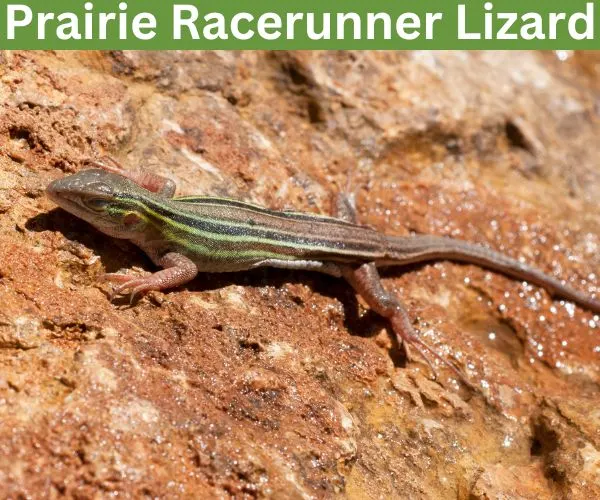
- Experience Level: Advanced
- Family: Teiidae
- Scientific Name: Cnemidophorus sexlineatus viridis
- Other Names: n/a
- Adult Size: 6 to 10.5 in. (15.24 to 26.67 cm.)
- Lifespan: 6 years
- Average Price Range: n/a
The prairie racerunner is found in southern and northern Texas. These lizards live in prairie habitats within the midwestern United States. Active during the day, you can find this lizard in the early morning. During the hottest time of the day they take shelter, and hide in the shade.
Prairie race runners have dark green or brown coloring. They have 7 yellow stripes that run down their body. The tail of this lizard is twice the length of its body, and they have a slender appearance.
Insects are what this lizard eats, spending their morning feeding. Racerunners are very quick and use their speed to escape predators like birds, snakes, and larger lizards.
49. Plateau Spotted Whiptail

- Experience Level: Advanced
- Family: Teiidae
- Scientific Name: Aspidoscelis septemvittatus
- Other Names: n/a
- Adult Size: 8 to 12.5 in. (20.3 to 31.75 cm.)
- Lifespan: 7 years
- Average Price Range: n/a
The plateau spotted whiptail is found in Texas and Mexico. This species is a hybridize of the eastern spotted whiptail. Whiptails are active during the day and spend their time darting around. Deserts, and semi-arid habitats like canyons, and hills are where this species lives.
Plateau spotted whiptails are medium-sized, with green, brown, or black coloring. They have 6 or 7 cream-colored stripes running down their body. The belly of this lizard is white, or blue. Females can have orange coloring on their throats. The tail of this lizard is very long, and they have slender bodies.
Insects are what this lizard feeds on, and they spend their time hunting. The spring is when these lizards breed, and they lay their eggs in the summer.
50. Checkered Whiptail

- Experience Level: Advanced
- Family: Teiidae
- Scientific Name: Aspidoscelis tesselata
- Other Names: n/a
- Adult Size: 4 to 6 in. (10.16 to 15.24 cm.)
- Lifespan: 7 years
- Average Price Range: n/a
Texas, Colorado, New Mexico, and northern Mexico are where the checkered whiptail lives. This species is active during the day. They live in rocky habitats, with canyons and hills.
Checkered whiptails are usually yellow or white. They are covered in black, or brown blotches which is where their name comes from. The legs of this lizard have dark spotting. They have a white underside, sometimes with a speckled pattern under their neck. Checkered whiptails are medium-sized, with a slender body, and long tail.
Insects are the main source of food this lizard eats. Being very quick this lizard’s speed helps them catch prey, or escape predators. This lizard is able to reproduce without fertilization. Females can lay up to 8 eggs, which hatch in the fall.
51. Desert Grassland Whiptail

- Experience Level: Advanced
- Family: Teiidae
- Scientific Name: Aspidoscelis uniparens
- Other Names: n/a
- Adult Size: 2..75 to 5.25 in. (7 to 13 cm.)
- Lifespan: 7 years
- Average Price Range: n/a
Native to North America, the desert grassland whiptail lives in grasslands, valleys, deserts, and hill habitats. These lizards are found in Texas, but also in other parts of the southwestern United States. Desert grassland whiptails may also live in urban areas and agricultural fields.
These lizards have slender bodies, with thin tails. They have six yellow lines that run down their body, with brownish to olive coloring. Desert grassland whiptails have a bluish tail when born. The belly of this lizard is pale, with large-keeled scales.
Termites, beetles, and grasshoppers are some of the prey these lizards eat. They have the capability to breed without male fertilization. Desert grassland whiptails are common in their range and have a stable population.
Iguanidae
52. Western Spiny-tailed Iguana

- Experience Level: Intermediate
- Family: Iguanidae
- Scientific Name: Ctenosaurua pectinata
- Other Names: Mexican Spinytail Iguana
- Adult Size: 4.3 ft. (1.3 m.)
- Lifespan: 60 years
- Average Price Range: $50
Mexican spinytail iguanas live in the southern tip of Texas. This species prefers a rocky habitat, with some trees. They sometimes live in groups but are typically solitary lizards. Active during the day, these lizards enjoy basking on rocks.
A very large species, the Mexican spinytail iguana gets its name from the roughly keeled scales that appear on its tail. Colors like brown, grey, black, and green are how they look. When born these iguanas have bright colors, which become less bright with age.
Fruit and insects, small animals, and eggs are what this lizard’s diet is made of. They are active in the spring to breed. Females use a burrow to nest and can lay up to 50 eggs. In parts of their range, these iguanas are considered threatened, due to hunting, and the pet trade.
FAQ
What is the largest lizard in Texas?
The Mexican spiny tail iguana is the largest lizard that lives in Texas and is capable of growing up to 4.6 ft. Other larger lizards include the Texas alligator lizard and the glass lizard, which is a legless type of lizard. The size of a lizard will vary on factors like their sex, and species.
Are there dangerous lizards in Texas?
In Texas, there are no poisonous, or venomous lizards that inhabit the state. Texas is home to venomous snakes, but all the lizards in the state are generally harmless. While some lizards may bite if provoked, their nips are not dangerous. The germs on the lizard are what can be dangerous to humans, and you should always wash your hands after you handle them.
In Texas what lizards are the most common?
Texas is home to a variety of lizard species, and most of them are active from the spring to fall months. The most common lizards in the state include anoles, skinks, and geckos. There are lots of these types of lizards that inhabit the state, and they are common to see in urban areas.
Wrapping up
Lizards are essential to the ecosystems they live in. These animals help control the populations of invertebrates like insects but are also used as food for larger animals like birds, or carnivorous animals.
Some lizards need to be protected since their populations are threatened and on the decline. Learning about the various lizards in Texas can help spread awareness to the ones that need protection, and also show you the amazing reptiles in the state.
Keeping lizards as a pet is common, and some of the species on this list may even make a good pet for the right owner. Before getting a lizard as a pet you should research the species, and find out the needs you must meet for them. Larger lizards can make bad pets for inexperienced owners, and you should fully research an animal in your plan on getting one.
You should not capture a lizard from the wild to keep as a pet as they can have parasites and diseases. Wild-caught lizards typically die quickly as pets and also must stay in the wild to help maintain their natural populations. Lizards in the wild, or as pets are always fun to analyze, as you can always learn something new.
Lizards in other nearby states
